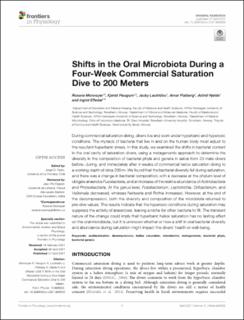| dc.contributor.author | Monnoyer, Roxane | |
| dc.contributor.author | Haugum, Kjersti | |
| dc.contributor.author | Lautridou, Jacky | |
| dc.contributor.author | Flatberg, Arnar | |
| dc.contributor.author | Hjelde, Astrid | |
| dc.contributor.author | Eftedal, Ingrid | |
| dc.date.accessioned | 2021-06-29T11:08:54Z | |
| dc.date.available | 2021-06-29T11:08:54Z | |
| dc.date.created | 2020-11-04T08:48:26Z | |
| dc.date.issued | 2021 | |
| dc.identifier.citation | Monnoyer, R., Haugum, K., Lautridou, J., Flatberg, A., Hjelde, A. & Eftedal, I. (2021). Shifts in the oral microbiota during a four-week commercial saturation dive to 200 meters. Frontiers in Physiology, 12: 669355. doi: | en_US |
| dc.identifier.issn | 1664-042X | |
| dc.identifier.uri | https://hdl.handle.net/11250/2762307 | |
| dc.description.abstract | During commercial saturation diving, divers live and work under hyperbaric and hyperoxic conditions. The myriads of bacteria that live in and on the human body must adjust to the resultant hyperbaric stress. In this study, we examined the shifts in bacterial content in the oral cavity of saturation divers, using a metagenomic approach to determine the diversity in the composition of bacterial phyla and genera in saliva from 23 male divers before, during, and immediately after four weeks of commercial heliox saturation diving to a working depth of circa 200 meters. We found that the bacterial diversity fell during saturation, and there was a change in bacterial composition; with a decrease at the phylum level of obligate anaerobe Fusobacteria, and an increase of the relative abundance of Actinobacteria and Proteobacteria. At the genus level, Fusobacterium, Leptotrichia, Oribacterium, and Veillonella decreased whereas Neisseria and Rothia increased. However, at the end of the decompression both the diversity and composition of the microbiota returned to pre-dive values. The results indicate that the hyperoxic conditions during saturation may suppress the activity of anaerobes, leaving a niche for other bacteria to fill. The transient nature of the change could imply that hyperbaric heliox saturation has no lasting effect on the oral microbiota, but it is unknown whether or how a shift in oral bacterial diversity and abundance during saturation might impact the divers’ health or wellbeing. | en_US |
| dc.language.iso | eng | en_US |
| dc.publisher | Frontiers | en_US |
| dc.rights | Navngivelse 4.0 Internasjonal | * |
| dc.rights.uri | http://creativecommons.org/licenses/by/4.0/deed.no | * |
| dc.title | Shifts in the oral microbiota during a four-week commercial saturation dive to 200 meters | en_US |
| dc.type | Peer reviewed | en_US |
| dc.type | Journal article | en_US |
| dc.description.version | publishedVersion | en_US |
| dc.rights.holder | © 2021 The Author(s) | en_US |
| dc.subject.nsi | VDP::Medisinske Fag: 700::Basale medisinske, odontologiske og veterinærmedisinske fag: 710::Medisinsk mikrobiologi: 715 | en_US |
| dc.subject.nsi | VDP::Medisinske Fag: 700::Klinisk odontologiske fag: 830::Oral medisin: 835 | en_US |
| dc.subject.nsi | VDP::Medisinske Fag: 700::Helsefag: 800::Yrkesmedisin: 809 | en_US |
| dc.source.pagenumber | 9 | en_US |
| dc.source.volume | 12 | en_US |
| dc.source.journal | Frontiers in Physiology | en_US |
| dc.identifier.doi | 10.3389/fphys.2021.669355 | |
| dc.identifier.cristin | 1844758 | |
| dc.relation.project | The Norwegian Research Council: 280425 | en_US |
| dc.source.articlenumber | 669355 | en_US |

